Volume 1, page 270-279
Page 270
of Antwerp, Michiel van Musscher [1], Godefridus Schalcken [2], Gerard de Lairesse [3], Adriaen van der Werff [4], Carel de Moor II [5] and Eglon van der Neer [6], praised for the strength of painting.
This much we estimate is enough to have said concerning his brushwork. We desire, though his life's rôle has stretched out far and wide, to say something about his natural and inimitable art of etching, which alone would have been enough to secure his reputation. There are several hundred of these known amongst amateurs of prints, also no less a number of pen sketches on paper, in which the states of mood in relation to all kinds of events reveal themselves so artistically and clearly in the expressions that it is amazing. Anger, hate, sadness, happiness, and so forth, everything is so naturally represented that one can read from the strokes of the pen what each is about to say. Among the many that stand out in this multitude is the depiction of Christ’s Last Supper [7], which I saw with the art-loving Sieuwert van der Schelling, now in the hands of the already mentioned Mister Willem Six, which is appraised at more than twenty ducats, even though it is only a single sketch in pen on paper. From this one must conclude that he was powerful in grasping a concrete conception with the presentation of many kinds of emotions.
Many spirited histories, figures, portraits and a multitude of male and female heads were done by him first with the needle, and among these many very finished ones, etched in copper, published by him as prints to the enjoyment of enthusiasts.
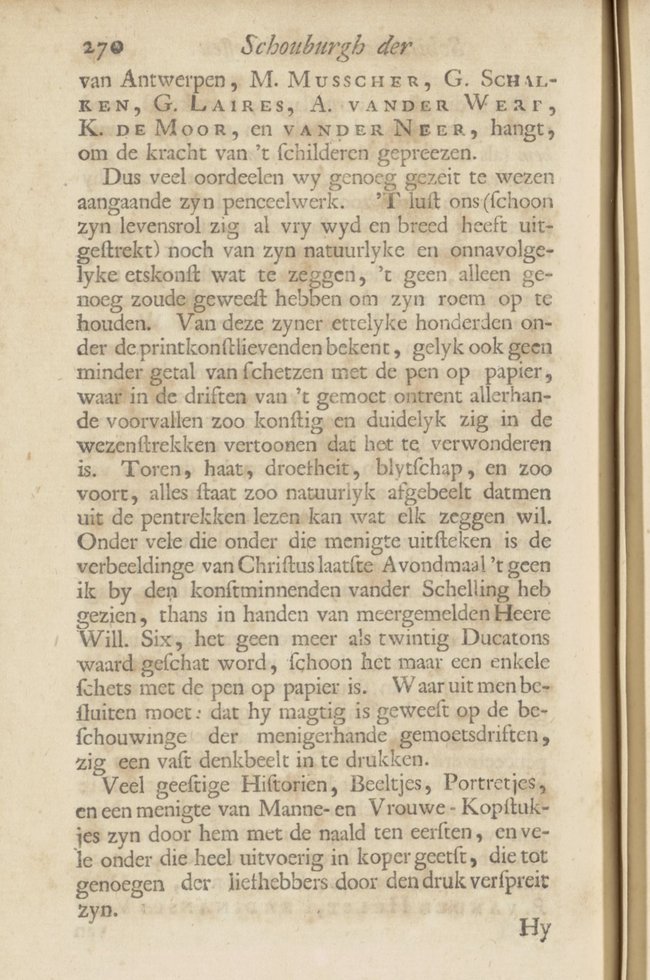

1
Michiel van Musscher
Self-portrait of Michiel van Musscher (1645-1705) with a miniature portrait, dated 1692
Florence, Galleria degli Uffizi, inv./cat.nr. 1778

2
Godefridus Schalcken
Self portrait of Godefridus Schalcken (1643-1706) with candlelight, dated 1695
Florence, Galleria degli Uffizi, inv./cat.nr. 1878

3
Eglon van der Neer
Self portrait of Eglon van der Neer (1634-1703), dated 1696
Florence, Galleria degli Uffizi, inv./cat.nr. 1872

4
Gerard de Lairesse
Self-portrait of Gerard de Lairesse (1640-1711), c. 1670
Florence, Galleria degli Uffizi, inv./cat.nr. A497

5
Adriaen van der Werff
Self-portrait of the artist with a double portrait of his wife Margaretha van Rees (1669-1732) and their daughter Maria (1692-1731), dated 1697
Florence, Galleria degli Uffizi, inv./cat.nr. 971

6
Carel de Moor (II)
Self-portrait of Carel de Moor (1656-1738), dated 1691
Florence, Galleria degli Uffizi, inv./cat.nr. 1890, no. 1892

7
Rembrandt
The Last Supper, dated 1635
Berlin (city, Germany), Kupferstichkabinett der Staatlichen Museen zu Berlin, inv./cat.nr. KdZ 3769
Page 271
He also had his own way of working up his etched plates afterwards and of preparing them, which he never let his students see. Their execution is also not to be comprehended. Thus this invention (just like the science of colouring glass as it was done by Dirck and Wouter Crabeth of Gouda) went to the grave along with the inventor.
In the small portrait of Johannes Lutma I [8] (to posit one as example for all) one sees three different impressions, one that is roughly sketched, one a little more developed with the addition of a window frame, and lastly one executed in detail and powerfully. One also discovers from the portrait of Johannes Cornelisz. Sylvius [9], which in the same way was first etched roughly, the delicate playful shadows and power being introduced afterward and handled as deftly and softly as can be done with the art of etching. This practice brought him great fame and no small profit, especially the trick of minor changes, or small and minimal additions, that he made to his prints, whereby the same ones were once again sold as if new. Yes the fervour was so great at that time that such people were not regarded as true connoisseurs who did not have the Juno with and without the crown, the Joseph with the white and brown throne, and more of the kind. Yes everyone had to have the woman by the stove, although one of his least works, with and without the white bonnet, with and without the key-shaped stove, which he had his son Titus van Rijn (ostensibly too unimportant for him) sell off.
Besides this he had so great a crowd of pupils who each yielded him 100 guilders annually, that Joachim von Sandrart, who associated with him,
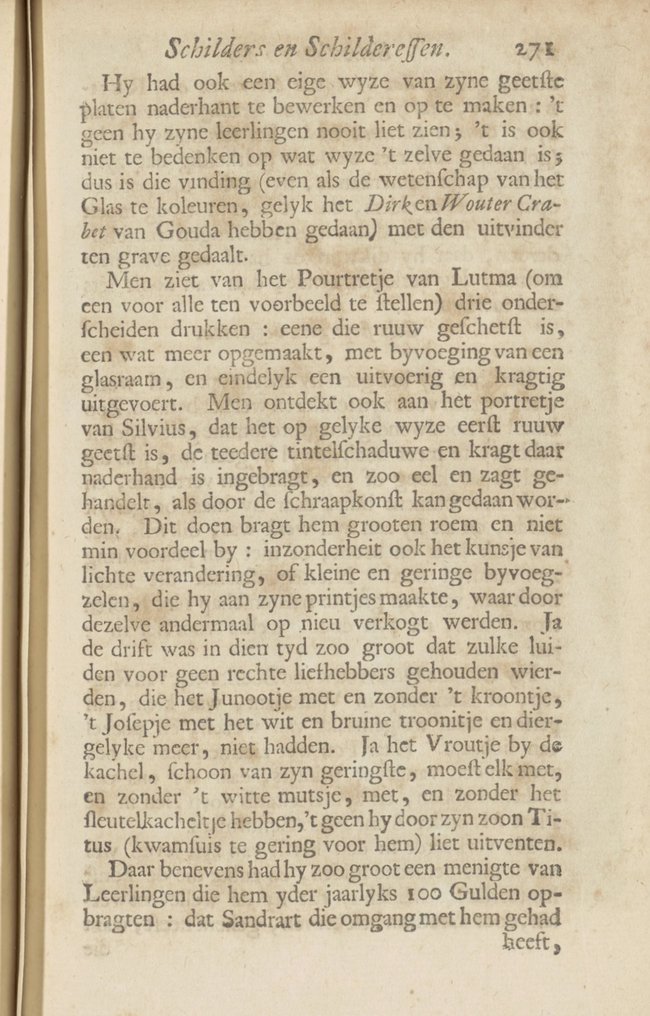

8
Rembrandt
Portrait of Johannes Lutma I (1584-1669), 1656
Amsterdam, Rijksprentenkabinet, inv./cat.nr. RP-P-OB-550

9
Rembrandt
Portrait of Johannes Cornelis Sylvius (1565-1638), dated 1646
Amsterdam, Rijksprentenkabinet, inv./cat.nr. RP-P-OB-566
Page 272
attested that he could calculate that Rembrandt had more than 2,500 guilders of income annually from his students. And still he was so fond of money (greedy does not sound good) that his students, noticing this, would occasionally, as a joke, paint nickels, dimes, quarters etc. on the floor or elsewhere where they were bound to catch his eye, for which he would mistakenly reach, but being embarrassed, never let on.
Money satisfies no desires.
Add to this what he gained from his brush, for he certainly had himself well-paid for his paintings. Thus he must have stashed away a great sum of money, all the more as he was not a man to consume much in taverns or company and even less at home, where he lived only soberly. And when he was at work, he often had a piece of bread with cheese or pickled herring for his meal. Despite all this, one did not hear news of his substantial estate trumpeted about after his death, which occurred in 1674.
He had as his wife a peasant woman from Raarep, or Ransdorp in Waterland, a little small in stature but with well-made features and a curvaceous body. One sees her portrait beside his in one of his prints, of which we made use, showing his portrait in Plate M below Anna Maria van Schurman.
In the twilight of his years he mainly associated with common people, and those who practised art. Perhaps he knew the rules of living well, written by Baltasar Gracián,
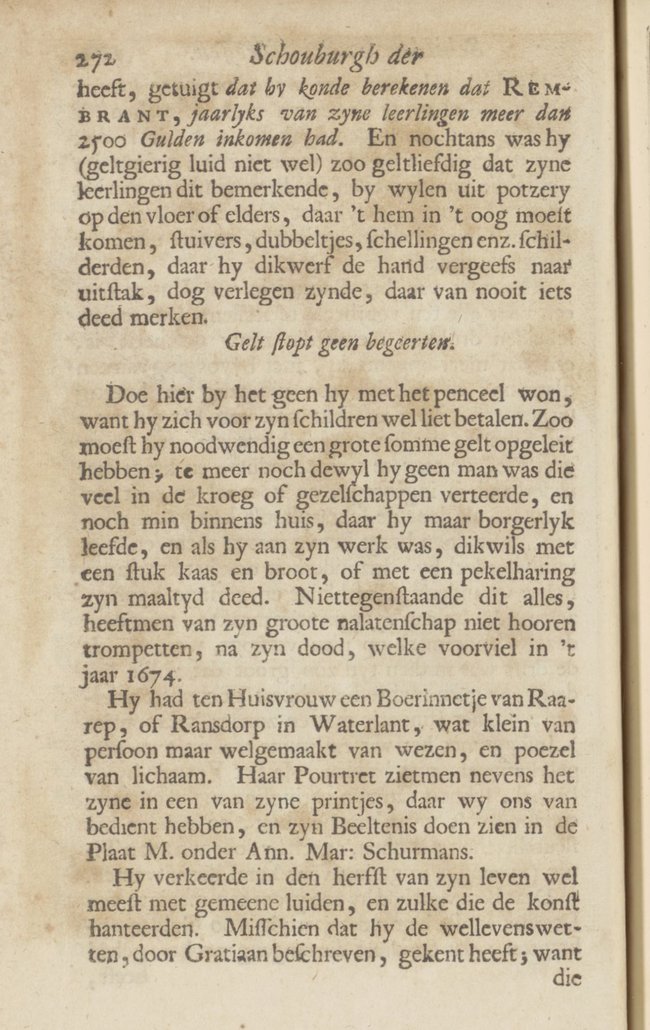
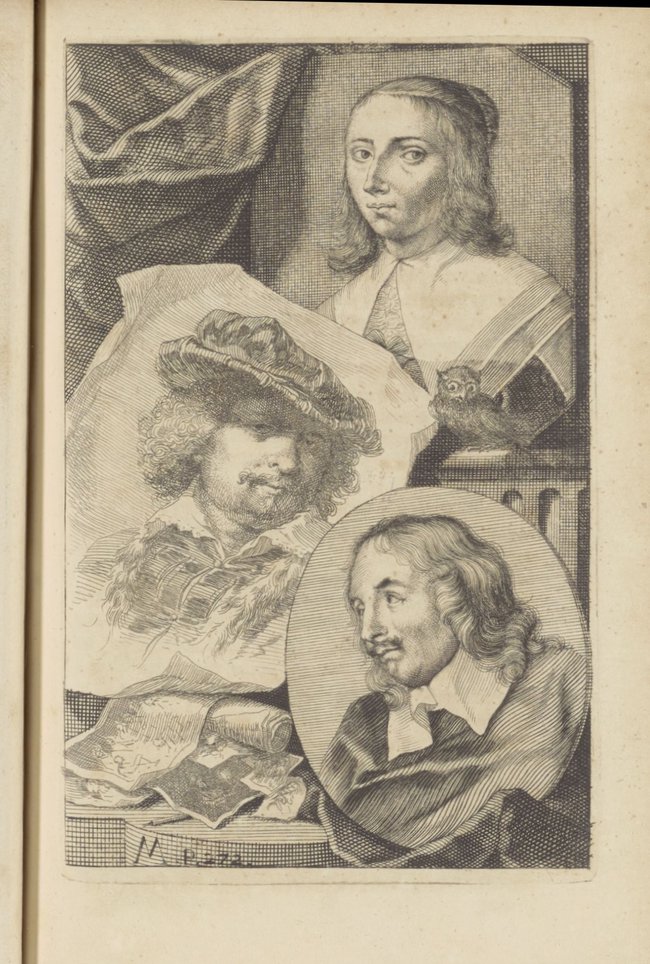
Page 273
for he says somewhere else: It is good to associate with excellent persons in order so to become, but once one is that, one should associate with the ordinary. And he gave this reason for it: If I want to give my mind repose, then it is not honour that I seek, but freedom.
His behaviour with respect to art (certainly in many aspects to be criticized) leads me to conclude that he did such intentionally, for had he adopted a style of painting which looked like that of others, or followed the lead of some famous Italian or other high-flyers with his brush, so would the world through comparison of one with the other have been able to decide on his merit, whereas now, by doing the opposite, he has skipped over this trial, doing as Tacitus said of Tiberius: that he avoided all things by which the people could have occasion to make a comparison between him and Augustus, whose memory he saw was dear to all.
Among the multitude of students which he nurtured in art the following are also mentioned, whom we have placed appropriately after their master because we do not know the time of their birth
CHRISTOPHER PAUDISS, a Nethersaxon (also mentioned by Sandrart) who later painted with Duke Albrecht Sigismund of Bavaria.
FRANS WULFHAGEN, born in Bremen, was able to imitate the handing of his master with much fame and to cling to it to the end of his life.
JÜRGEN OVENS was a commendable master in histories and night scenes and introduced
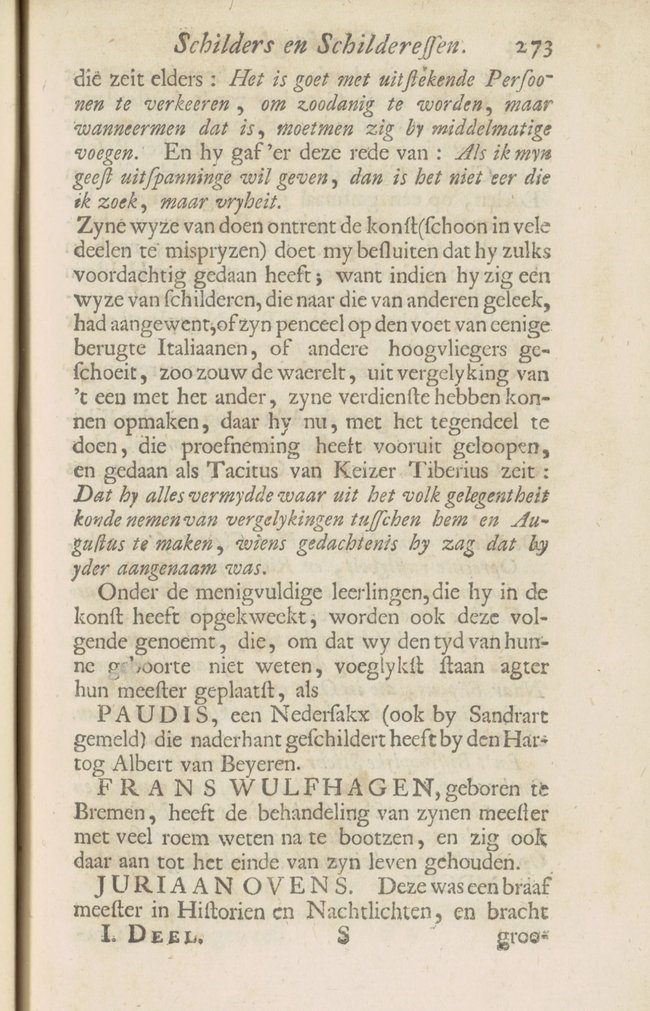
Page 274
great power to these. A large work by him may be seen in the gallery of the Amsterdam city hall, depicting the conspiracy of the old Batavians in the holy or Schaaker Forest, where Claudius Civilis, having invited the most important chiefs and nobles to a feast, persuades them to his advantage to throw the yoke of the Romans from their necks [10]. He was still alive in 1657 and painted for the Duke of Holstein [= Friedrich III von Schleswig-Holstein-Gottorf] in Fredrikstad. We have placed his portrait, painted by Gerard Dou [11], in Plate N, below Adriaen Brouwer.
His portraits are also especially praised.
On the depiction of the nobly born Mister Godard, Baron of Amerongen, Lord of Ginkel etc., painted by Jürgen Ovens [12], Vondel expresses himself thus:
To paint the Heer Godart, the painter mixed,
Sincere calm and knightly elegance
In the eyes, from which one sees the honour of Utrecht shine forth:
Just as they sparked Frederik with their dash,
When at the Baltic court the breast plate honoured him:
Now he courageously plies through the Spanish ocean
To Phillip, who triumphed in East and West,
And casts lightning on the curse of the Turkish half moon.
Madrid will cheer at the lustre of Amerongen,
And the Episcopal Sticht, when it receives the emissary
Of the state at the great palace, along a street of tongues.
The alliance extends from the free Netherlands.
Then the evening star welcomes the seven stars of the States.
Freedom may count on the hero’s loyalty.
MDCLX
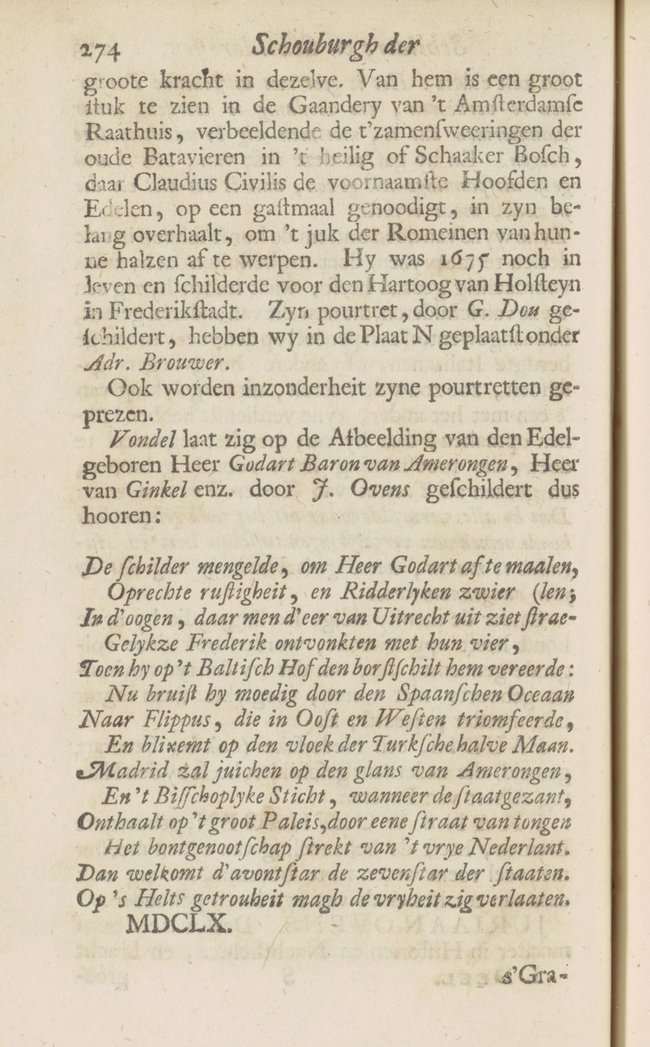

10
and Jürgen Ovens Govert Flinck
The Midnight Conspiracy of the Batavians under Claudius Civilis (Tacitus, Historiae IV, 13-15, 61), November 1659-February 1660 and September 1662
Amsterdam, Koninklijk Paleis (Paleis op de Dam)

11
manner of/circle of Gerard Dou
Tronie of an unknown old man (not Jürgen Ovens), c. 1640-1645
New York City, The Leiden Collection, inv./cat.nr. JvS-101

12
Jürgen Ovens
Portrait of Godard Adriaan van Reede (1621-1691), dated 1660
Amerongen, Stichting Kasteel Amerongen, inv./cat.nr. KA 810
Page 275
The Hague early on produced commendable artists, not to limit this fame to walled cities only.
PIETER MONICKX, or Monix (as he spelled his name) was born in 1606. Wanderlust and the urge to see renowned works of art drove him to Rome, where he spent thirteen years on end painting and drawing for the pope [= Urban VIII].
He painted companies in the manner of Gerard Pietersz. van Zijl, but one sees these rarely in these parts, though one finds his drawings with amateurs now and then. However, he died in The Hague being more than 80 years old.
I do not know where his contemporary, JAN van de VELDE II, was born. He is best known for the handsome landscapes by him that come out in print and are widely known among lovers of prints.
He had a brother, but whether he was older or younger than he I have not been able to ascertain. He was named
ESAIAS van de VELDE and painted battles and other equestrian combats, and poaching scenes.
He also often lent out his brush to decorate the works of other masters with figures, horses and troupes of horsemen dressed in the Spanish manner.
In the year 1626 he lived in Haarlem, and in 1630 in Leiden. His brushwork was esteemed at that time, and dearly paid for.
People believe that Willem van de Velde I, the pen draughtsman, father of Adriaen and Willem van de Velde II, born in 1610, was the brother of both the previously mentioned artists.
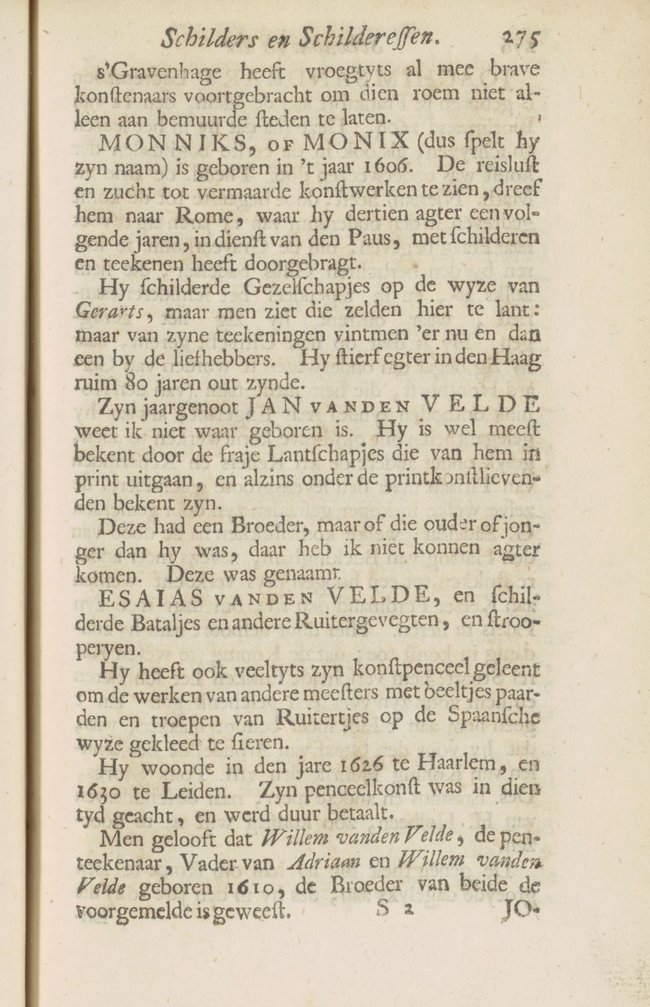
Page 276
JOACHIM von SANDRART was born in Frankfurt am Main on the 12th of May 1606. At the age of 15 years (after having been taught the first rudiments of art by Johann Theodor de Bry and Matthäus Merian I) he was driven by craving for art to go on foot to Prague to learn the art of engraving with the famous Aegidius Sadeler II, who advised him against this and instead for the art of painting, advice that he took. He later travelled to Utrecht, where he went to be instructed by Gerard van Honthorst, who (having been summoned by the King) took him along to England, where he found opportunity to see commendable artworks, including among others the XII emperors and empresses painted life-sized by Titian. They were engraved in copper by the mentioned Aegidius Sadeler [13]; which artworks along with other works were sold at a high price after the death of George Villiers, 2nd Duke of Buckingham to Emperor Ferdinand III to grace his palace. Spurred on by this he improved so much in art that the King (to wit, Charles Stuart) had him paint various pieces and gave him a gift for his diligence. And what made him all the more beloved at the court was that he was able artfully to imitate the portraits of King Henry VIII, Thomas More and Desiderius Erasmus after paintings by Hans Holbein II for the Earl of Arundel.
The desire to see Rome grew by the day, so that in the year 1627 he shipped from
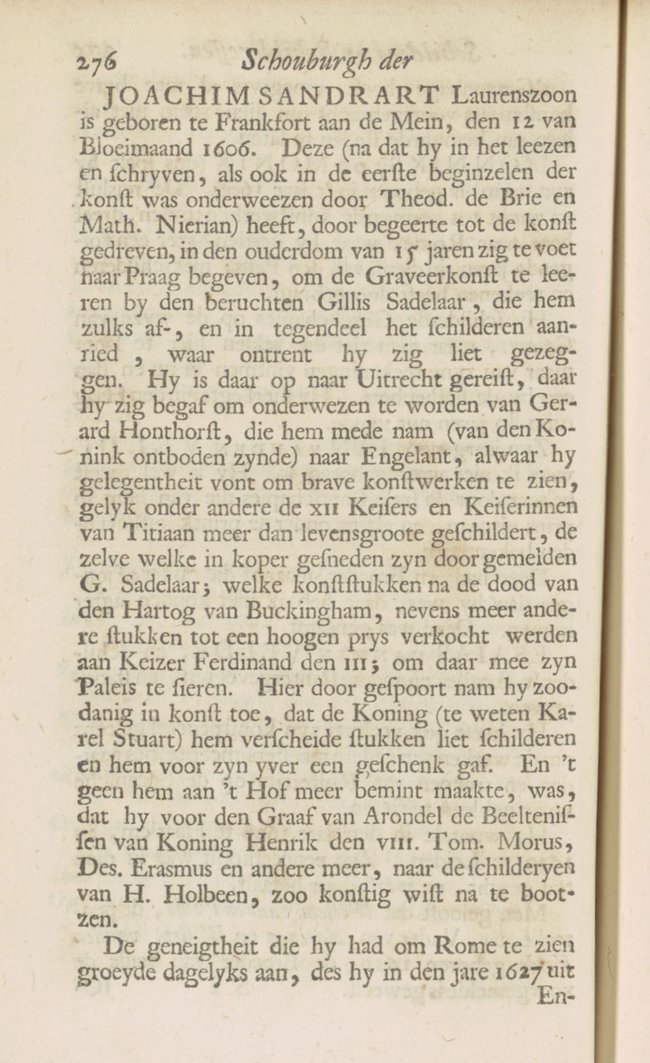

13
Aegidius Sadeler (II) after Tiziano published by Marcus Sadeler
Portrait of the Roman emperor Titus (39-81), c. 1597-1629
London (England), British Museum, inv./cat.nr. 1878,0713.2654
Page 277
England to Venice, where he was welcomed by the painter Johann Liss, otherwise known as Pan, and Nicolas Régnier and taken to see all the splendour that Venice owns, especially the matchless artworks by Titian and Paolo Veronese in the church of St. Sebastian.
From there he left for Bologna, where he was graciously received by Michiel le Blon, a famous engraver and his first cousin on his father’s side, who accompanied him first to Florence and then to Rome, where he found several of the painters whom he knew, including among others Pieter van Laer or Bamboccio, with whom he most associated.
The first pieces that he made in Rome were Jerome and Mary Magdalene which, bought by cardinal Barberini, were sent as gift to the King of Spain [= Philip IV]. Later he made an altarpiece for the church of Holy Mary, depicting the 12 mysteries of the rosary, which made his name renowned, so that when the King of Spain ordered that 12 pieces of painting by twelve of the most important painters to be found in Rome be purchased, there was one by each of Guido Reni, Guercino, Giuseppe Cesari, Massimo Stanzione, Orazio Gentileschi, Pietro da Cortona, Valentin de Boulogne, Andrea Sacchi, Giovanni Lanfranco, Domenichino, Nicolas Poussin, and one by Sandrart.
Later the Duke Vincenzo Giustiniani put him in charge of the engravers of statues in his gallery.
Having spent some years in Rome in the practice of art, he found himself inclined to see other cities of Italy. To this end
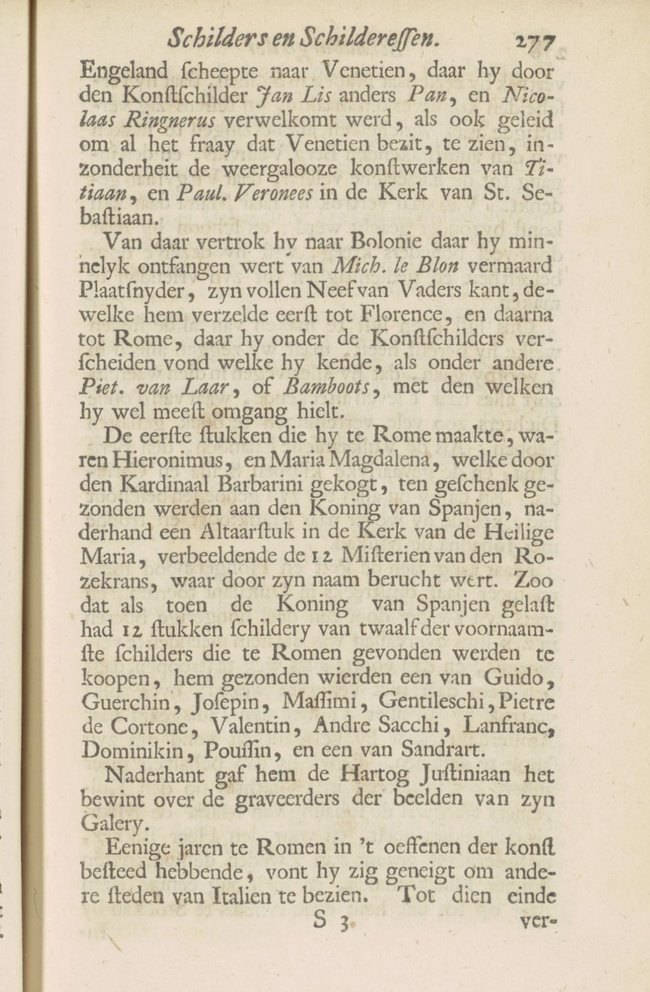
Page 278
he left first for Naples in Sicily, where he made various works of art and at the same time amused himself with the making of various sketches of the fire-belching Mount Vesuvius and the entry way to the Elysian Fields commemorated by Virgil. From there he left for Malta, where his art was greatly esteemed, and though this attracted the envious, he was able to turn them into his friends by his politeness and helpfulness.
It does not please us to make a list of all the cities to which he travelled, but we only say in passing that everywhere in that part of the world he sketched everything after life of which the old poets have recorded so many stories, such as the volcanic islands, Mount Etna and the dangerous cliffs of Scylla and Charybdis. And after having seen everything to his satisfaction he returned to Frankfurt and married Johanna de Milkau.
But seeing that the plague and famine increased ever more in that region of Germany and that his brother-in-law had already been attacked in his house by a group of hungry farmers who intended to strangle him and then strip away everything, he thought it was not safe there, so that he left in haste with his family for Amsterdam, where he found opportunity to practice his art. So that he painted, among other works of art, the entry of Maria de’ Medici in the hospital on the Kloveniersburgwal [14], and for Mister Cornelis Bicker [15-18] and for Pieter Spiering van Silvercroon, the emissary of Sweden, portraits of their families. And he remained there for some years until an inheritance in Stockau near
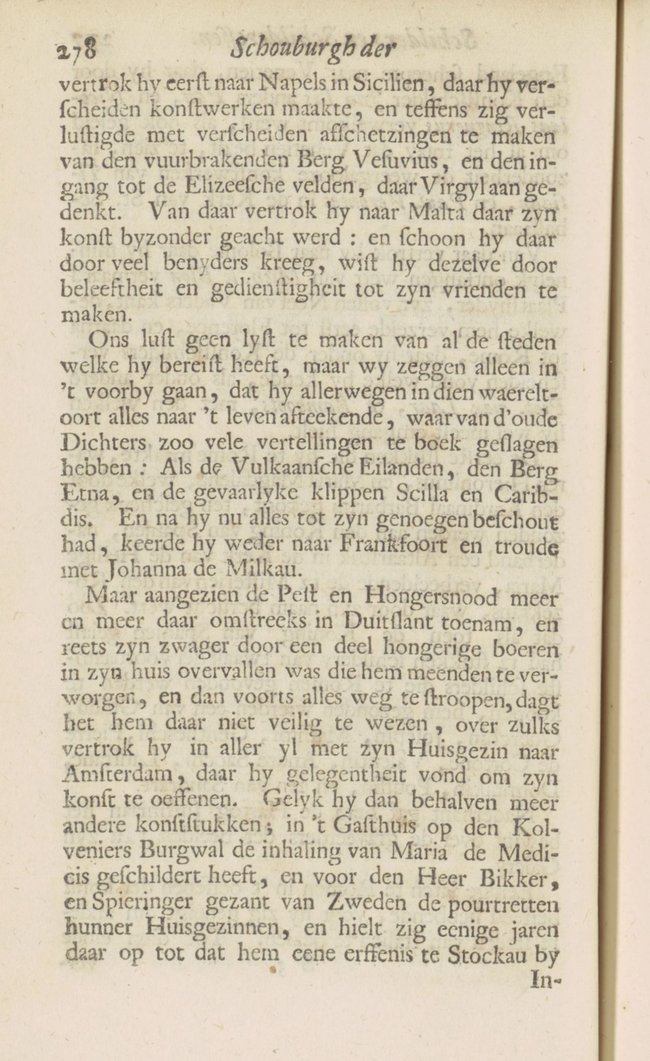

14
Joachim von Sandrart (I)
The company of Captain Cornelis Bicker and Lieutenant Frederick van Banchem, waiting to welcome Maria de' Medici, dowager queen of France, September 1638, 1640
Amsterdam, Rijksmuseum, inv./cat.nr. SK-C-393

15
Joachim von Sandrart (I)
Portrait of Jacob Bicker (1612-1676), dated 1639
Amsterdam, Amsterdam Museum, inv./cat.nr. SA 2078

16
Joachim von Sandrart (I)
Portrait of Alida Bicker (1620-1702), dated 1641
Amsterdam, Amsterdam Museum, inv./cat.nr. SA 2077

17
Joachim von Sandrart (I)
Portrait of Hendrick Bicker (1615-1651), dated 1639
Amsterdam, Amsterdam Museum, inv./cat.nr. SA 7400

18
Joachim von Sandrart (I)
Portrait of Eva Geelvinck (1619-1698), dated 1639
Amsterdam, Amsterdam Museum, inv./cat.nr. SA 7401
Page 279
Ingolstadt in the duchy of Neuburg came his way. But aware that the estate and the pleasure orchards were badly dilapidated, he sold all that he possessed in Amsterdam in the way of paintings, drawings and other handsome things, including 2 books with Italian drawings, for 3,500 guilders to the mentioned Spiering. In addition his drawings fetched 4,555 guilders at a public sale, and his paintings 40,566 guilders, for the restoration of that estate. But it was hardly rebuilt, and the estate able to yield, and it was entirely burned down by the French. But he built it up anew, more beautiful than it had been, and fearing a second attack, sold it and settled in Augsburg, where he made many artworks for Maximilian I, Elector of Bavaria and Emperor Ferdinand III (who honoured him with a gold chain and a medal) and in particular various martyrdoms of saints and the discovery of the Holy Cross† by Helena § in Brno in Moravia [19].
--------
§ Helena. The wife of Flavius Valerius Constantinus Chlorus and the mother of Constantine the Great, was born in Brittany in the year 272 after the birth of Christ.
† Holy Cross. Sulpicius Severus tells about the miraculous discovery of the cross: That Helena, above mentioned, while digging up the hill or levelled top of the mount of Calvary to found a temple in that location, found three crosses, of which she was able by revelation to distinguish the cross of Jesus from those of the murderers by having a dead person touched by it, at once returned to life. According to the writer this is to have transpired in the year 326 after Christ’s birth.
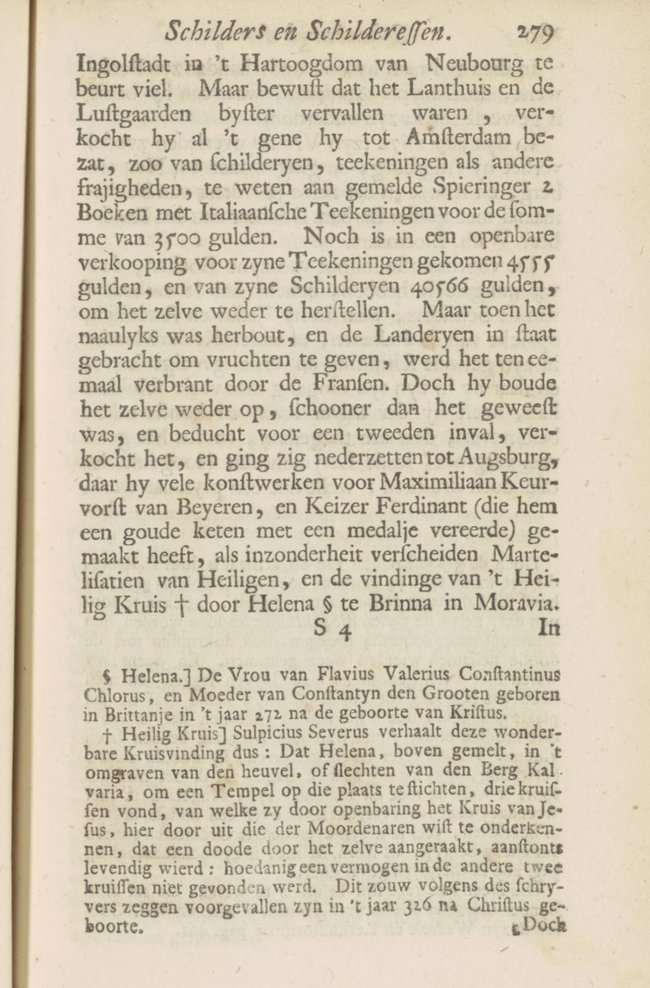

19
Joachim von Sandrart (I)
The dicovery of the Holy Cross, dated 1655
Brno, Capuchin Church of the Discovery of the Holy Cross

